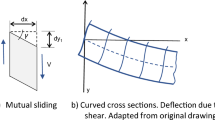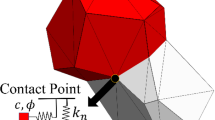Abstract
The present paper introduces a new elastoplastic beam model for reinforced concrete based on a higher-order beam model previously developed (Int J Numer Methods Eng. https://doi.org/10.1002/nme.5926, 2018). Steel and concrete are both defined as elastoplastic materials. The beam model represents the concrete body whereas rebars are given a specific discretization. A Rankine criterion is used for concrete in both tension and compression, and a closed-form solution for the local projection of the trial stress on the yield surface is formulated. Steel rebars are modelled with 1D bar elements and added to the global stiffness of the concrete beam model. The kinematics of the higher-order beam model is enriched by a systematic method with displacement modes. This extension of the kinematics leads to local accuracy and yields results comparable to 3D computations. The present reinforced concrete model is validated through a set of case studies. Implemented within the software programs of the company Strains Engineering, the objective is to develop a fast computing and efficient model that can be directly used by engineers.


























Similar content being viewed by others
References
Corre G, Lebée A, Sab K, Ferradi MK, Cespedes X (2018) The asymptotic expansion load decomposition elasto-plastic beam model. Int J Numer Methods Eng. https://doi.org/10.1002/nme.5926
Lubliner J, Oliver J, Oller S, Oñate E (1988) A plastic-damage model for concrete. Int J Solids Struct 25:299
Govindjee S, Kay GJ, Simo JC (1995) Anisotropic modelling and numerical simulation of brittle damage in concrete. Int J Numer Methods Eng 38(21):3611. https://doi.org/10.1002/nme.1620382105
Mazars J (1986) A description of micro- and macroscale damage of concrete structures. Eng Fract Mech 25(5):729. https://doi.org/10.1016/0013-7944(86)90036-6
Oller S, Barbat AH (2005) Moment-curvature damage model for bridges subjected to seismic loads. Comput Methods Appl Mech Eng 195(33–36):4490–4511
Chen W (2007) Plasticity in reinforced concrete. J. Ross Publishing Classics. J. Ross Publishing, Plantation. https://books.google.fr/books?id=FGp-U4hNjggC
Feenstra PH, Borst RD (1996) A composite plasticity model for concrete. Int J Solids Struct 33(5):707. https://doi.org/10.1016/0020-7683(95)00060-N
Grassl P, Lundgren K, Gylltoft K (2002) Concrete in compression: a plasticity theory with a novel hardening law. Int J Solids Struct 39(20):5205. https://doi.org/10.1016/S0020-7683(02)00408-0
Salari MR, Saeb S, Willam KJ, Patchet SJ, Carrasco RC (2004) A coupled elastoplastic damage model for geomaterials. Comput Methods Appl Mech Eng 193(27):2625
Grassl P, Jirásek M (2006) Damage-plastic model for concrete failure. Int J Solids Struct 43(22):7166. https://doi.org/10.1016/j.ijsolstr.2006.06.032
Meschke G, Lackner R, Mang A (1998) An anisotropic elastoplastic-damage model for plain concrete. Int J Numer Methods Eng 42:703
ACI (2014) Building code requirements for structural concrete and commentary. ISBN-10: 087031744X, ISBN-13: 978-0870317446
Dallot J, Sab K, Forêt G (2009) Limit analysis of periodic beams. Eur J Mech A Solids 28(1):166. https://doi.org/10.1016/j.euromechsol.2008.04.001
de Buhan P, Sudret B (1999) A two-phase elastoplastic model for unidirectionally-reinforced materials. Eur J Mech A Solids 18(6):995. https://doi.org/10.1016/S0997-7538(99)00109-6
Bleyer J, de Buhan P (2016) A numerical approach to the yield strength of shell structures. Eur J Mech A Solids 59:178. https://doi.org/10.1016/j.euromechsol.2016.03.002
Epstein M (1979) Thin-walled beams as directed curves. Acta Mech 33(3):229. https://doi.org/10.1007/BF01175918
Rizzi N, Tatone A (1996) Nonstandard models for thin-walled beams with a view to applications. J Appl Mech 63(2):399. https://doi.org/10.1115/1.2788878
Lofrano E, Paolone A, Ruta G (2013) A numerical approach for the stability analysis of open thin-walled beams. Mech Res Commun 48:76. https://doi.org/10.1016/j.mechrescom.2012.12.008
Piana G, Lofrano E, Manuello A, Ruta G, Carpinteri A (2017) Compressive buckling for symmetric TWB with non-zero warping stiffness. Eng Struct 135:246. https://doi.org/10.1016/j.engstruct.2016.12.038
Ibrahimbegović A, Frey F (1993) An efficient implementation of stress resultant plasticity in analysis of Reissner–Mindlin plates. Int J Numer Methods Eng 36(2):303. https://doi.org/10.1002/nme.1620360209
Pham BH, Brancherie D, Davenne L, Ibrahimbegovic A (2012) Stress-resultant models for ultimate load design of reinforced concrete frames and multi-scale parameter estimates. Comput Mech 51(3):347–360
Bui NN, Ngo M, Nikolic M, Brancherie D, Ibrahimbegovic A (2014) Enriched Timoshenko beam finite element for modeling bending and shear failure of reinforced concrete frames. Comput Struct 143:9–18
Owen DR, Hinton E (1980) Finite elements in plasticity, vol 271. Pineridge Press, Swansea
Spacone E, Filippou FC, Taucer FF (1996) Fibre beam-column model for non-linear analysis of R/C frames: Part I. Formulation. Earthq Eng Struct Dyn 25:711
Spacone E, Limkatanyu S (2000) Response of RC members including bond-slip effects. ACI Struct J 97(6):831–839
Moulin S (2010) Elément de poutre multifibre (droite), R3.08.08. Code\_Aster
Mazars J, Kotronis P, Ragueneau F, Casaux G (2006) Using multifiber beams to account for shear and torsion. Applications to concrete structural elements. Comput Mech Appl Mech Eng 195:7264
Jukić M, Boštjan B, Ibrahimbegovic A (2014) Failure analysis of reinforced concrete frames by beam finite element that combines damage, plasticity and embedded discontinuity. Eng Struct 75:507–527
Marini A, Spacone E (2006) Analysis of reinforced concrete elements including shear effects. ACI Struct J 103:645
Bitar I, Kotronis P, Benkemoun N, Grange S (2018) A generalized Timoshenko beam with embedded rotation discontinuity. Finite Elem Anal Des 150(April):34. https://doi.org/10.1016/j.finel.2018.07.002
Bitar I, Grange S, Kotronis P, Benkemoun N (2018) A comparison of displacement-based Timoshenko multi-fiber beams finite element formulations and elasto-plastic applications. Eur J Environ Civ Eng 22(4):464. https://doi.org/10.1080/19648189.2016.1210031
Navarro Gregori J, Miguel Sosa P, Fernández Prada MA, Filippou FC (2007) A 3D numerical model for reinforced and prestressed concrete elements subjected to combined axial, bending, shear and torsion loading. Eng Struct 29(12):3404. https://doi.org/10.1016/j.engstruct.2007.09.001
Di Re P, Addessi D, Filippou FC (2018) Mixed 3D beam element with damage plasticity for the analysis of RC members under warping torsion. J Struct Eng 144(6):04018064. https://doi.org/10.1061/(ASCE)ST.1943-541X.0002039
Capdevielle S, Grange S, Dufour F, Desprez C (2016) A multifiber beam model coupling torsional warping and damage for reinforced concrete structures. Eur J Environ Civ Eng 20(8):914. https://doi.org/10.1080/19648189.2015.1084384
Bairan Garcia JM, Mari Bernat AR (2007) Multiaxial-coupled analysis of RC cross-sections subjected to combined forces. Eng Struct 29(8):1722. https://doi.org/10.1016/j.engstruct.2006.09.007
Bairan Garcia JM, Mari Bernat AR (2007) Shear-bending-torsion interaction in structural concrete members: a nonlinear coupled sectional approach. Arch Comput Methods Eng 14(3):249. https://doi.org/10.1007/s11831-007-9007-5
Mohr S, Bairan Garcia JM, Mari Bernat AR (2010) A frame element model for the analysis of reinforced concrete structures under shear and bending. Eng Struct 32(12):3936. https://doi.org/10.1016/j.engstruct.2010.09.005
Ferradi MK, Lebée A, Fliscounakis A, Cespedes X, Sab K (2016) A model reduction technique for beam analysis with the asymptotic expansion method. Comput Struct 172:11. https://doi.org/10.1016/j.compstruc.2016.05.013
Corre G, Lebée A, Sab K, Ferradi MK, Cespedes X (2018) Higher-order beam model with eigenstrains: theory and illustrations. ZAMM J Appl Math Mech Z Angew Math Mech. https://doi.org/10.1002/zamm.201700180
Kupfer H, Hilsdorf HK, Rusch H (1969) Behavior of concrete under biaxial stresses. ACI J Proc 66:656
Simo J (1985) A finite strain beam formulation. The three-dimensional dynamic problem. Part I. Comput Methods Appl Mech Eng 49(1):55. https://doi.org/10.1016/0045-7825(85)90050-7
Godio M, Stefanou I, Sab K, Sulem J (2016) Multisurface plasticity for Cossear materials: plate element implementation and validation. Int J Numer Methods Eng 108(5):456–484
Simo J, Hughes T (1998) Computational inelasticity. Interdisciplinary applied mathematics. Springer, New York
Silhavy M (2013) The mechanics and thermodynamics of continuous media. Theoretical and mathematical physics. Springer, Berlin
De Soza T (2015) Eléments MEMBRANE et GRILLE\_MEMBRANE, R3.08.07. Code\_Aster
Radfar S, Foret G, Sab K (2012) Modélisation du comportement à rupture (peeling-off) de poutres BA renforcées soumises à un essai de flexion 4 points. Revue des composites et des matériaux avancés 22(2):171–185. https://doi.org/10.3166/rcma.22.171-185
Comité Euro International du Béton (1993) CEB-FIP model code 90. CEB Bulletins. ISBN: 978-0-7277-1696-5. https://www.fib-international.org/publications/ceb-bulletins/ceb-fip-model-code-90-pdf-detail.html
Flejou J (2011) Réponse statique d’une poutre béton armé (section en T) à comportement linéaire, V3.01.111. Code\_Aster
Author information
Authors and Affiliations
Corresponding author
Additional information
Publisher's Note
Springer Nature remains neutral with regard to jurisdictional claims in published maps and institutional affiliations.
Rights and permissions
About this article
Cite this article
Corre, G., Lebée, A., Sab, K. et al. A new higher-order elastoplastic beam model for reinforced concrete. Meccanica 55, 791–813 (2020). https://doi.org/10.1007/s11012-019-01003-5
Received:
Accepted:
Published:
Issue Date:
DOI: https://doi.org/10.1007/s11012-019-01003-5




